William Shakespeare would be most perturbed by the question, “To pee or not to pee?” I’m sure he would not appreciate the play on words used in reference to his quote in Hamlet, “To be or not to be.” But he may have appreciated my suggestions about going to the bathroom while hiking in the woods or snow. After all, in the 16th century, I would think Shakespeare did just that.
The question for snowshoers then is – to pee (or poop) or not to pee (or poop) in the snow. Let’s look at this subject matter more carefully.
Some of the links in this article may contain affiliate links. When you purchase using these links, part of the proceeds go to Snowshoe Mag. Additionally, as Amazon Associates, we earn from qualifying purchases. Please see our disclosure for more details.
What…no indoor plumbing or toilet paper?
Kathleen Meyer, the author of How to Shit in the Woods, wrote that in this day and age, we are “Potty-trained on indoor plumbing and accustomed to our privacy, comfort, and convenience.” It is difficult for most people to get used to toileting in the woods without plumbing or conveniences. But mother nature seems to provide a room with a view.
Bringing toilet paper on a backcountry adventure is a must. But, if you forget it, there are other options. Using nature’s products, such as mullein, large leaf aster, wooly lamb’s ear, or moss, are some natural alternatives to toilet paper in the backcountry. And in winter, snowballs make a toilet paper substitute. Though they are cold, snowballs are functional.
After going to the bathroom while hiking, you should always use some hand sanitizer. Additionally, wash your hands with biodegradable soap that is unscented to keep critters away. Try Sea to Summit’s Wilderness Wash liquid soap or Pocket Wilderness Wash dry soap. However, do not wash in a lake, river, or stream.
Read More: Winter Camping Checklist: What To Bring on Your Trip
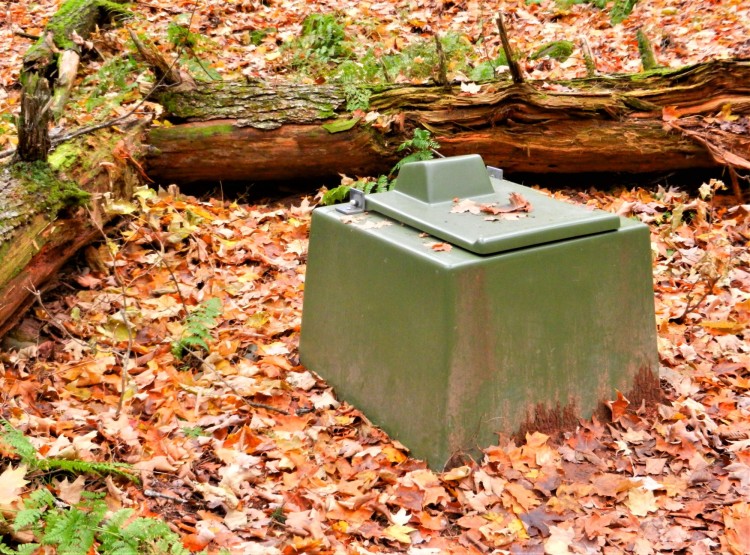
This rare pit toilet seat may be found at some designated campsites but not along the trail. Photo: Jim Joque
What about the cathole and packing it out?
Both catholes and packing it out are options when going to the bathroom while hiking.
The cathole
The method of digging a cathole and burying solid waste is explained by Leave No Trace as an acceptable method for decomposition.
Specifically, find a suitable spot at least 200 feet (about 75 paces) from any water source, trail, and camp. Select an inconspicuous location that most likely would not be traveled on. Then, dig a cathole in ideally organic soil 6 to 8 inches (15-20 cm) deep and 4 to 6 inches (10-15 cm) in diameter. Finally, deposit your waste, bury it, and cover it with natural materials.
Packing it out
Packing it out is an alternative to burying waste, which is necessary for river canyons, sea kayaking waters, rock climbing locations, pristine alpine sites, and designated areas where solid waste must be removed.
There are commercial products on the market designed for packing out. A few examples are toilet bags (like those at Green Elephant), DIY poop tubes, and portable toilets (like the Reliance Luggable Loo). Leave No Trace also provides a video about the disposable W.A.G. bag (waste alleviation and gelling) that uses a chemical that gels and breaks down waste. Complete bathroom kits are also available, including the Cleanwaste Go Anywhere Toilet Kit or PACT Outdoors Outdoor Bathroom Kit.
If using a small plastic bag or toilet paper to pack out waste, perhaps purchase a doggie stash (like the Olive and Odin Poop Stash). Or consider creating a homemade system for packing out.
In my Leave No Trace trainer and backpacking courses I taught at the University of Wisconsin-Stevens Point, I provided each camp group with a homemade toilet kit. Inside a large zip-lock bag included the following:
- metal trowel
- toilet paper
- hand sanitizer
- several small plastic zip-lock bags
- small paper bags.
Where we camped, we could leave human waste in a cathole, but we had to pack out the toilet paper. Using the small plastic bag to hold wasted paper, students would place it in a small paper bag that they put in their individual backpacks for packing out.
Read More: 8 Backpacks for the Snowshoer
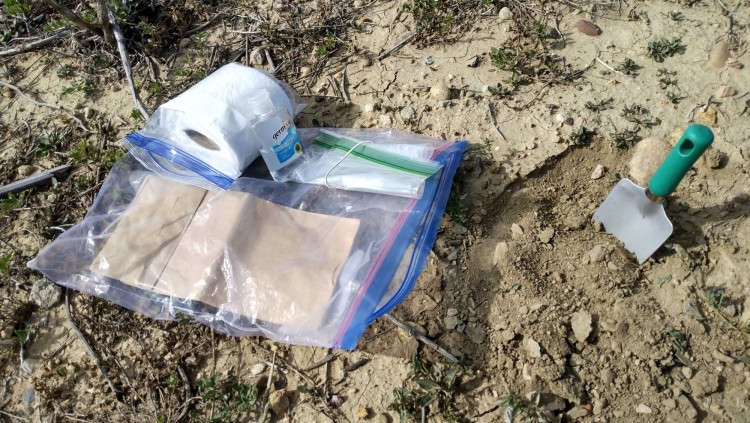
Make your own poop kit: large zip-lock bag, metal trowel, toilet paper, hand sanitizer, small plastic zip-lock bags, and paper bags. Photo: Jim Joque
What about in snow on frozen ground?
Snow or ice on the frozen ground creates a major challenge for cathole diggers. Leave No Trace provides helpful information in “A guide to pooping outside in the snow.” The advice begins with planning ahead and going before you leave. But in many situations, when you have to go to the bathroom while hiking in the snow, plan to pack it out.
If you can’t pack it out, the last resort that Leave No Trace recommends is going 200 feet from any water source (frozen or buried in snow) and from trails and camps. Dig down in the snow and deposit your waste. Then cover with snow. The waste will be there come spring and will eventually break down into the soil.
Another option on frozen ground is to find a suitable location and dig through snow to the ground. Then with a metal trowel, shovel, knife, or ice axe, chip away at the soil. Eventually, and with some effort, you can loosen the soil and chip away enough to dig a cathole. Do your thing and bury it with the soil you removed and top it with snow.
Read More: Leave No Trace Principles for Snowshoers
What about peeing in the snow?
Urinating on the ground or in the snow is considered environmentally okay by experts, as long as you pee 200 feet from a water source, trail, and camp. The urine breaks down into the soil. In alpine areas where there is sensitive vegetation, it is recommended to urinate on rocks.
Should you have the urge to sign your name in the snow, be considerate of others and cover it up with fresh snow so as to leave no trace of your signature. For squatters, shovel snow out of a small area, find a means of keeping your balance, and be sure pants (try She-Fly’s Outdoor Pants) and boots are out of the way. You can also consider purchasing a urine funnel. If on a hill, be uphill to allow pee to flow away from you.
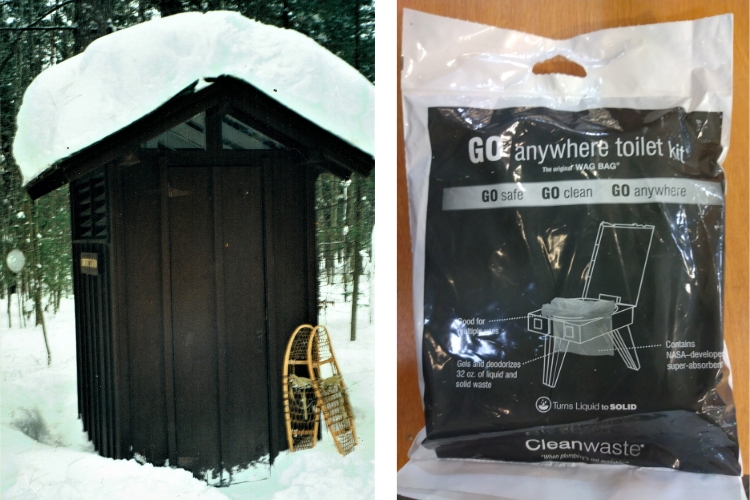
When we don’t have the luxury of an outhouse, we can pack it out using a commercial pack-out kit that can be used with or without a bucket or portable toilet. Photos: Jim Joque
Some noteworthy resources
As a supplement to the information above, check out the additional resources below about going to the bathroom while hiking and limiting stressors about the process.
Books
How to shit in the Woods: This 4th edition book by Kathleen Meyer sold some 3 million copies in eight different languages. So, someone must be listening to her advice. Meyer writes that her book “presents a collection of techniques to assist backwoods enthusiasts still fumbling with their trousers.” Regarding its relevance, she says it is “applicable to a variety of seasons, climates, and terrains.”
Meyer’s book is found to be interesting, entertaining, and educational, providing valuable information on various techniques and products for managing outdoor waste. A chapter is specifically written for women. Other chapters address the health risks of drinking wilderness water and the consequences if not treated properly, environmental concerns regarding elimination in the backcountry, and much more.
Everyone Poops: A fun children’s book that my wife and I purchased for both our granddaughters years ago was Everyone Poops by Taro Gomi (in Japanese titled Minna Unchi; translated by Amanda Mayer Stinchecum).
This pictural little book tells kids that all animals defecate and helps children to remove embarrassment or shame they may have regarding the act of pooping since it is a natural part of life. Youth and young adults who find embarrassment or shame in responding to nature’s call in the backcountry can also benefit.
How-tos
Leave No Trace Center for Outdoor Ethics: Principle number 3 of Leave No Trace is “Dispose of Waste Properly.” Since waste covers a wide range of materials, the organization provides information on disposing of human waste properly. For the purpose of preventing pollution of water sources and spreading disease, as well as preventing others from finding it, disposing of human waste in the backcountry is of utmost importance.
Recreational Equipment, Inc: REI Co-op has comprehensive information that addresses this topic with “How To Go to the Bathroom in the Woods.” Additionally, they have videos that include “Backpacking: How to poop in the woods,” which is informative and demonstrates the art of digging a cathole. Of interest, too, is their article “Backpacking With Your Period.”
With the multiple resources available, perhaps pick up a copy of Meyer’s book and be prepared as you head out on snow trails. In doing so, you may eliminate embarrassment and shame when going to the bathroom while hiking, contribute to keeping the environment healthy, and leave no trace. Or at least, very little trace.
What are your recommendations for going to the bathroom in the woods? Please share your thoughts with us in the comments below.
Read Next: Tips and Tricks for Cold Weather Backpacking and Winter Camping

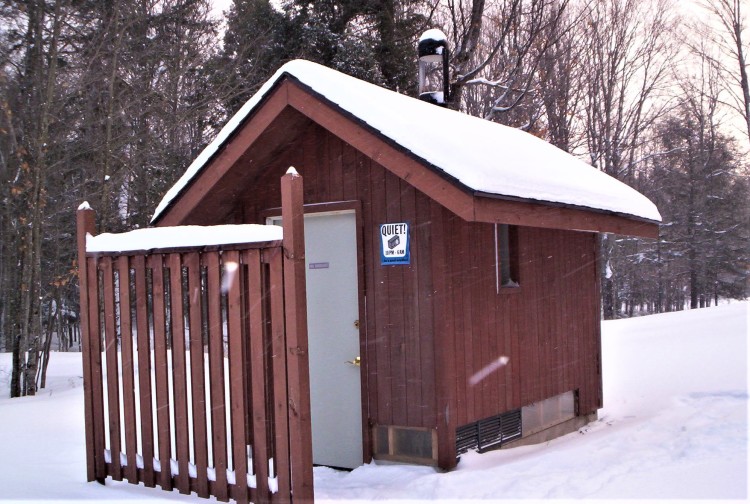
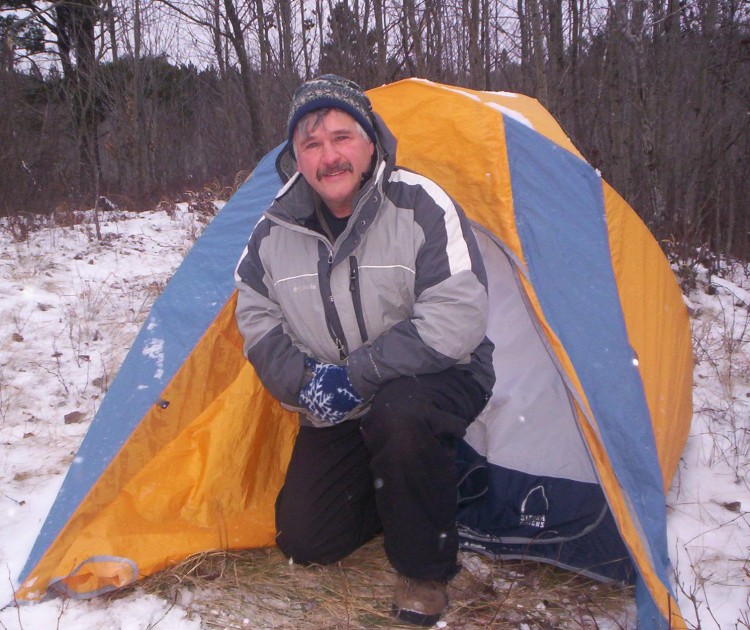
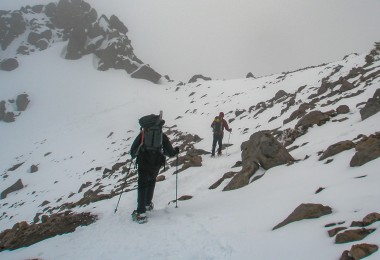
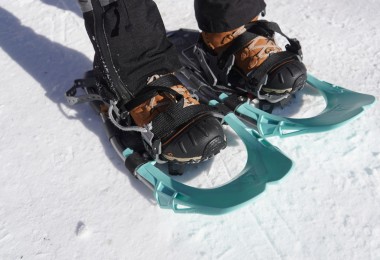
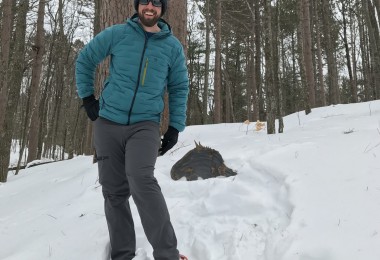

Leave a Comment